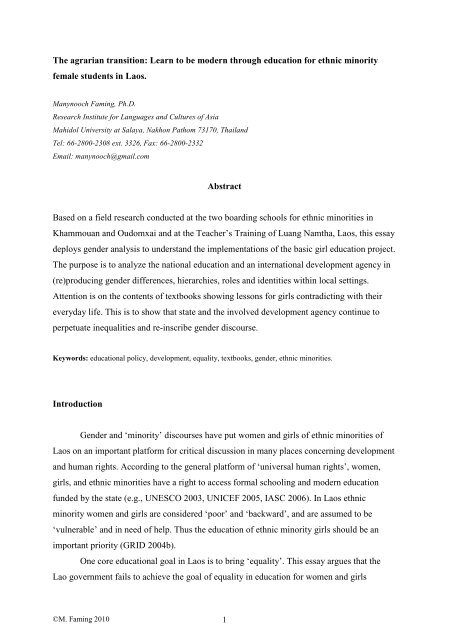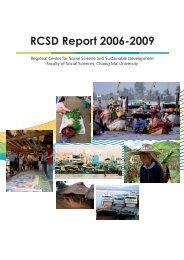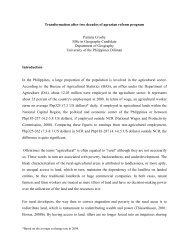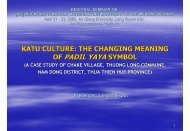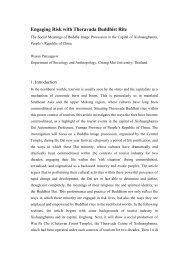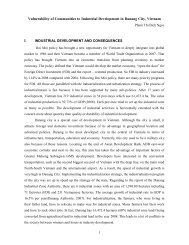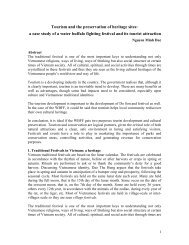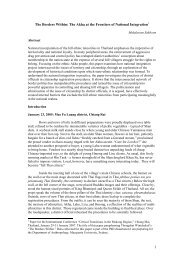The agrarian transition: Learn to be modern through ... - RCSD
The agrarian transition: Learn to be modern through ... - RCSD
The agrarian transition: Learn to be modern through ... - RCSD
- No tags were found...
Create successful ePaper yourself
Turn your PDF publications into a flip-book with our unique Google optimized e-Paper software.
<strong>The</strong> <strong>agrarian</strong> <strong>transition</strong>: <strong>Learn</strong> <strong>to</strong> <strong>be</strong> <strong>modern</strong> <strong>through</strong> education for ethnic minorityfemale students in Laos.Manynooch Faming, Ph.D.Research Institute for Languages and Cultures of AsiaMahidol University at Salaya, Nakhon Pathom 73170, ThailandTel: 66-2800-2308 ext. 3326, Fax: 66-2800-2332Email: manynooch@gmail.comAbstractBased on a field research conducted at the two boarding schools for ethnic minorities inKhammouan and Oudomxai and at the Teacher’s Training of Luang Namtha, Laos, this essaydeploys gender analysis <strong>to</strong> understand the implementations of the basic girl education project.<strong>The</strong> purpose is <strong>to</strong> analyze the national education and an international development agency in(re)producing gender differences, hierarchies, roles and identities within local settings.Attention is on the contents of textbooks showing lessons for girls contradicting with theireveryday life. This is <strong>to</strong> show that state and the involved development agency continue <strong>to</strong>perpetuate inequalities and re-inscri<strong>be</strong> gender discourse.Keywords: educational policy, development, equality, textbooks, gender, ethnic minorities.IntroductionGender and ‘minority’ discourses have put women and girls of ethnic minorities ofLaos on an important platform for critical discussion in many places concerning developmentand human rights. According <strong>to</strong> the general platform of ‘universal human rights’, women,girls, and ethnic minorities have a right <strong>to</strong> access formal schooling and <strong>modern</strong> educationfunded by the state (e.g., UNESCO 2003, UNICEF 2005, IASC 2006). In Laos ethnicminority women and girls are considered ‘poor’ and ‘backward’, and are assumed <strong>to</strong> <strong>be</strong>‘vulnerable’ and in need of help. Thus the education of ethnic minority girls should <strong>be</strong> animportant priority (GRID 2004b).One core educational goal in Laos is <strong>to</strong> bring ‘equality’. This essay argues that theLao government fails <strong>to</strong> achieve the goal of equality in education for women and girls©M. Faming 2010 1
ecause those in power are overwhelmingly Lao men (i.e., in the LPRP), who make decisionsfor all women. As we shall see, a specific program, the Basic Education (Girls) Project orBEGP, with one of its components, funded by AusAid, designed for specific groups, is <strong>to</strong>bring <strong>to</strong> women and girls of ethnic minority groups in particular a limited ‘equality’, so as <strong>to</strong>integrate them in<strong>to</strong> the ethnic Lao male-dominant society.<strong>The</strong> design of the national education for ethnic minorities is based on the assumptionsthat they are weak, vulnerable, disadvantaged and ‘backward’, and thus in need of <strong>modern</strong>knowledge so that they may <strong>be</strong>come ‘civilized’(e.g., Keyes 1991, Harrell 1995, Hansen 1999,Faming 2008). This article looks at another aspect of the ethnic and minority discourse inLaos.Education for minority women is, in fact, no different from the national education forall in Laos, in the sense that all girls and women are taught <strong>to</strong> <strong>be</strong> ‘Lao women’, prepared <strong>to</strong>live their lives as good progressive patriotic citizens of Laos and <strong>to</strong> participate in the nationaleconomic system. <strong>The</strong>y are promised ‘equality’ and ‘equity’. This article is an analysis ofhow national policies, supported and influenced by foreign aid, are designed andimplemented at the local level and how they reshape local worlds <strong>through</strong> gender andeducation discourses. It covers the assumptions <strong>be</strong>hind the policy making and strategy<strong>through</strong> examination of an educational development project for girls - namely, the BasicEducation (Girls) Project (BEGP). This national development project worked closely with theLao Women’s Union (LWU). I explore the BEGP <strong>through</strong> a BEGP operational componentfunded by AusAid: the Lao-Australia Basic Education Project (LABEP). <strong>The</strong> article alsoconsiders how the involvement of international development projects influences the policyand strategy for national education for girls and women in Laos.Basic Education (Girls) Project (BEGP)Background <strong>to</strong> the Non-Formal Education (NFE) involvementBefore 1994, there were no specific educational programs for girls of ethnicminorities. <strong>The</strong>re were only campaigns <strong>to</strong> encourage women of rural areas (regardless ofethnicity) <strong>to</strong> join the literacy programs run by the Non-Formal Education Department (NFE)of the MOE and <strong>to</strong> respond <strong>to</strong> the recruiting programs of the LWU. However, later, specificeducation for ethnic minority girls resulted from meetings and various conferences organizedby non-socialist countries, in which representatives of the LWU have participated. <strong>The</strong> World©M. Faming 2010 2
Conference <strong>to</strong> Review the UN Decade for Women (Nairobi 1985), with the theme of‘Equality, Development and Peace’, seems <strong>to</strong> have <strong>be</strong>en the first of these events. Thisconference emphasized social harmony amongst men and women, equality <strong>be</strong>fore the law,and economic redistribution. It provided a new international role for the LWU, asrepresentative of all women in the Lao PDR. <strong>The</strong>n in 1993 Lao government representativesattended the Sixth Regional Conference of Ministers of Education and Those Responsible forEconomic Planning in Asia and the Pacific, held in Kuala Lumpur, Malaysia. Standing face<strong>to</strong> face with those from many <strong>modern</strong> and more economically advanced countries, Laorepresentatives considered Third World women’s contribution <strong>to</strong> economic growth. At thisconference, the phrase “Education For All” specifically included education for disadvantagedgroups.In 1994, with UNESCO’s assistance and funding from the Norwegian government,the Lao MOE launched the Women’s Literacy and Basic Skills Training Project, supervisedby the Department of Non-Formal Education, <strong>to</strong> provide literacy programs for young women,as well as ‘cultural education’ for ethnic minority women, which included ‘skills training’ aswell as learning <strong>to</strong> read and write Lao. This project was the first one specifically for women.<strong>The</strong> department’s major task - <strong>to</strong> eradicate illiteracy - was <strong>to</strong> <strong>be</strong> carried out <strong>through</strong> itsLocal Community <strong>Learn</strong>ing Centers (CLC), located in each district <strong>through</strong>out the country.During my data collection in the year 2000, I had a chance <strong>to</strong> conduct a formal interview withthe deputy direc<strong>to</strong>r of Non-Formal Education (NFE). According <strong>to</strong> him, Community<strong>Learn</strong>ing Centers had <strong>be</strong>en in operation since 1990 or earlier.<strong>The</strong> NFE and its CLCs designed education not only <strong>to</strong> improve Lao language skillsbut also <strong>to</strong> promote the cultural ideas of the ethnic Lao concerning gender. That is, womenare assumed <strong>to</strong> <strong>be</strong> good at weaving while men are <strong>be</strong>tter at carpentry, etc. 1 Suchunderstandings have remained the basis for policy planning and implementation, and werereflected in BEGP planning and implementation.<strong>The</strong> NFE was responsible for this type of training until the formation of a new EthnicMinorities Education unit under the General Education Department. This unit operated fromthe late 1970s <strong>to</strong> the mid-1990s. In 1995, the Lao Women’s Union sent representatives <strong>to</strong> the1 As an indication of some aspects of Lao cultural ideas about gender, the account of an official of NFE, givenduring an informal conversation, can <strong>be</strong> taken as an example. “Lao people have rules for both men and women,of course. Men are stronger so we (men) have an obligation <strong>to</strong> build and maintain the house. Women are notsupposed <strong>to</strong> <strong>be</strong> on the roof of the house, either. That’s <strong>to</strong>o dangerous for them, but also it shows disrespectful<strong>be</strong>haviour <strong>to</strong> their father or older brothers…” (an interview conducted 20 May 2000). In fact, women are not <strong>to</strong><strong>be</strong> anywhere in physically higher positions than men in Lao culture. For example, women are <strong>to</strong> kneel down,while men stand up, in offering food <strong>to</strong> monks in the early morning.©M. Faming 2010 3
Fourth World Conference on Women in Beijing, China. After this conference, the Ministry ofEducation created another new division, the Girls and Ethnic Minority Education Unit(GEMEU), which <strong>to</strong>ok over all educational and training programs for girls and women ofethic minorities in 1998.<strong>The</strong> Girls (Gender) and Ethnic Minority Education Unit (GEMEU)This Unit was set up <strong>to</strong> develop plans and policies, and <strong>to</strong> implement developmentprojects exclusively for girls’ education. <strong>The</strong> main task is <strong>to</strong> increase enrolment rates and <strong>to</strong>reduce dropout rates among girls, and especially girls of ethnic minorities. <strong>The</strong> Unit has twofemale direc<strong>to</strong>rs. One is an ethnic Lao woman, who handles all meetings with donors andinternational experts on gender <strong>to</strong> discuss planning for GEMEU for the long and short terms.<strong>The</strong> other is a Lao-educated Hmong woman, who is in charge of implementation. Throughher frequent encounters with foreigners, donors and consultants, the first direc<strong>to</strong>r learned thatthe term ‘gender’ sells. In an interview, she <strong>to</strong>ld me that her Unit had changed the ‘G’ inGEMEU <strong>to</strong> represent ‘Gender’ rather than ‘Girls’. She felt that the use of this term wouldallow the Unit <strong>to</strong> draw more donors, and that it <strong>be</strong>tter indicated the government’s intentionsand international commitments made during international conferences and congresses <strong>to</strong>improve the status of women (not just girls) <strong>through</strong> formal education. 2Details of the projectIn Septem<strong>be</strong>r 1998, at the ADB headquarters in Manila, the Lao government,represented by MOE, signed an Agreement of Understanding with the ADB and AusAid andcontracted <strong>to</strong> implement the Basic Education (Girls) Project (BEGP), which was thenlaunched in 1999. <strong>The</strong> first (unofficial) project document stated that “the project aims <strong>to</strong>expand access <strong>to</strong> improve education for girls in ethnic minority areas. . . the long-termobjective [is] <strong>to</strong> bring more women in<strong>to</strong> the mainstream of socioeconomic development. . . Inthe short term [this is] <strong>to</strong> improve primary education for girls in ethnic minority areas. Boys2 It should <strong>be</strong> noted that at the <strong>be</strong>ginning of the unit operation (1998-2000), ethnic minority boys and men werenot mentioned much in the unit’s agenda. This is based on my observation and personal experience whileworking at MOE (1998-1999). Thus, at the point <strong>to</strong> changing the unit’s name from girl <strong>to</strong> gender was a reactionof the unit direc<strong>to</strong>r, who followed the ‘gender’ discourse which has <strong>be</strong>en heavily applied <strong>to</strong> only females ratherthan a social cultural roles meaning of males and females.©M. Faming 2010 4
will also <strong>be</strong>nefit, but the major educational gain will <strong>be</strong> for girls. . ”. (LABEP 1998: 1). 3However, the official (i.e., approved by the Prime Minister’s Office) project implementationdocument (including the project’s short term and longer term purpose) were issued in 2000.<strong>The</strong> following presents the revised and official purposes of the BEGP:1. <strong>The</strong> long term purpose is <strong>to</strong> enable all women, all ethnic minorities regardless ofsex and age, <strong>to</strong> participate in socio-economic development, as well as <strong>to</strong> improvethe quality of education.2. <strong>The</strong> short term purpose is <strong>to</strong> develop educational access for girls and ethnicminorities <strong>to</strong> <strong>be</strong> able <strong>to</strong> complete basic primary education, the government’scompulsory education, as well as <strong>to</strong> <strong>be</strong> able <strong>to</strong> continue with secondary educationand vocational training. 4To achieve these two purposes, MOE’s strategy was <strong>to</strong> cover 10 provinces and onespecial zone. <strong>The</strong>se areas included 50 main districts and two special districts. <strong>The</strong>re were <strong>to</strong><strong>be</strong> two phases: phase one was <strong>to</strong> cover six provinces and 12 districts from 2000-2003, whilephase two was <strong>to</strong> cover five provinces and 38 or 40 districts from 2003-2005. However, bythe end of 2005 phase one had not <strong>be</strong>en able <strong>to</strong> reach the above target and so it was extended<strong>to</strong> 2007. Meanwhile, the project continued <strong>to</strong> <strong>be</strong> funded by ADB and AusAid. However,BEGP officially ended on 31 July 2007. According <strong>to</strong> the project report (informal copy), theproject closed with success, having achieved all targets planned since the <strong>be</strong>ginning.I have argued elsewhere that the government attempts <strong>to</strong> reach its ideal of ‘equality’<strong>through</strong> education for ethnic minorities. Such cases of boarding schooling for ethnicminorities in Laos, the government aims <strong>to</strong> provide ‘equality’ and ‘equity’ for ethnic minoritychildren. That is, by providing full scholarship <strong>to</strong> attend either or both primary and secondaryeducation at the state funded boarding schools, ethnic minority children can equally enjoy full3 This statement can also <strong>be</strong> found on the ADB official website (http://www.adb.org/gender/practices/education/lao001.asp). This particular quote was an excerpt from a two page ‘unofficial’ interim report given <strong>to</strong>me by the first Lao-Australian Basic Education Project (LABEP) consultant. This document was obtained inNovem<strong>be</strong>r 1998.4 This is my translation from the Lao text from the MOE (1999) publication on the establishment of GEMEU.<strong>The</strong> official English version has: “<strong>The</strong> long-term objective of the Project is <strong>to</strong> bring more women in<strong>to</strong> themainstream of socioeconomic development by progressively improving their education level”. <strong>The</strong>re are thussome few small differences in the Lao and English versions of the document. <strong>The</strong>se differences can <strong>be</strong> readdifferently. For example, as emphasized in the text, the Lao version seems <strong>to</strong> associate women (i.e., “. . . allwomen and ethnic minorities of both sexes regardless of ages…”) with ethnic minorities generally, while theEnglish version only mentions bringing women (assumingly regardless of ethnic group) in<strong>to</strong> the nationalsocioeconomic development. <strong>The</strong> Lao text thus seems <strong>to</strong> reveal the government’s concern and discourses abouteducational development, poverty, gender and ethnic minorities.©M. Faming 2010 5
access <strong>to</strong> education. However, not all ethnic minority children can <strong>be</strong> accepted <strong>to</strong> this typeschooling but the ‘prestigious’ ones. To <strong>be</strong> specific, for example, in the selection process foradmission and for scholarships, there is a concept of ‘<strong>be</strong>tter or <strong>be</strong>st or special or gifted’attached <strong>to</strong> this the selection process. This is only an example <strong>to</strong> show that even the specificschooling for specific groups of students aimed <strong>to</strong> provide equality and equity seem <strong>to</strong> <strong>be</strong>confined within hierarchy system. Similarly, I will demonstrate an attempt <strong>to</strong> fulfill thenational ‘equality’ goal <strong>through</strong> this specific project designed for girls, with the hope ofintegrating ‘all women’ and all ethnic minorities in<strong>to</strong> the mainstream society and economy, aswell as in<strong>to</strong> the Lao nation-state. In other words, the two goals of this specific girls’ educationproject, as part of the overall national education development project, were also attempts <strong>to</strong>achieve ‘equality’ based on an understanding that women and girls, especially of ethnicminorities, were unable <strong>to</strong> participate in socio-economic development, and that they lackedaccess <strong>to</strong> education.<strong>The</strong>re were three operational components of the BEGP. Component One was <strong>to</strong>expand access and improve retention; Component Two, <strong>to</strong> improve relevance, quality, andefficiency; and Component Three, <strong>to</strong> strengthen management systems and capacity.Component One and Component Three were <strong>to</strong> <strong>be</strong> carried out under a loan from ADB, whileComponent Two was funded by AusAid. Although these components were supported fromdifferent financial sources, the main purpose was <strong>to</strong> assist the Lao government <strong>to</strong> expand itsnational education. I will provide brief descriptions of the tasks of the three components.Component One: Expanding access and improving retention 5To increase access, the component was designed with three tasks. <strong>The</strong>y were: 1. <strong>to</strong>build more new schools, as well as <strong>to</strong> renovate existing old schools at the village base, so thatschools would <strong>be</strong> closer <strong>to</strong> the homes of the girls; 2. <strong>to</strong> encourage community cash and kindcontributions and engagement; and 3. <strong>to</strong> promote gender awareness.Component Two: Improving relevance, quality and efficiencyThis component was funded at around US$4.3 million by AusAid. It was calledLABEP, or Lao-Australia Basic Education Project. <strong>The</strong> project was established <strong>to</strong> deal with5 I am using the Lao text <strong>be</strong>cause it is longer and gives more detail of what the government wanted <strong>to</strong> achievewith this project, as the English version omits many passages.©M. Faming 2010 6
problems reported by MOE and international experts. <strong>The</strong> problem and proposed solutionwere that “the limited participation of ethnic minority groups in formal education results no<strong>to</strong>nly from the remoteness and mobility of their settlements, but also from cultural andlinguistic differences that make remaining and learning in schools difficult. [Thus] theComponent will create an integrated quality improvement system <strong>to</strong> support increasedenrolment and retention of children, particularly girls, in multi-grade schools and schools inethnic minority areas”. 6 ‘Quality improvement’ here means improving the quality ofpedagogy: the task of this project was mainly <strong>to</strong> produce teaching and learning materials <strong>to</strong>handle, for example, multi-grade teaching, the teaching of Lao as the national language, andthe teaching of mathematics, as well as <strong>to</strong> produce locally relevant curricula. <strong>The</strong>se teachinglearningmaterials were supplements <strong>to</strong> the existing national curriculum and textbooks.A second task of Component Two was <strong>to</strong> develop 260 trainers of trainers, who in turnwould train 4,000 teacher trainees and an additional 50 ‘pedagogical advisers’ for 50 districts.Finally, the Component provided scholarships for 300 ethnic minority students,including 200 girls, who would <strong>be</strong> trained at the three teacher training institutions at LuangNamtha, Xieng Khouang, and Saravan. 7 <strong>The</strong>y were <strong>to</strong> <strong>be</strong> trained under two systems: 5+4 and8+3. 8 <strong>The</strong>se two systems were designed specially for ethnic minorities according <strong>to</strong> a‘Sandwich Delivery Model’ (explained <strong>be</strong>low).Component Three: Strengthening Management Systems and Capacity.This component’s task was <strong>to</strong> strengthen MOE’s institutional capacity <strong>to</strong> manage,plan, and moni<strong>to</strong>r the primary education system at all levels. That is, the work of thiscomponent was <strong>to</strong> produce high-quality information (i.e., handbooks and/or computer basedinformation) readily available <strong>to</strong> all education managers <strong>through</strong>out the country. According <strong>to</strong>6 Ministry of Education. 2000. Basic Education Girls Project. Laos. (This is my own translation from the Laolanguage version, with my emphasis).7 <strong>The</strong>se three institutions are the regional teacher training institutions for all students, regardless of ethnicity.However, students of these three institutions are mostly non-ethnic-Lao. For example, there are more Hmongstudents at the Xieng Khuang Teacher Training College; and at Luang Namtha there are more Khmu, Phounoy,Hmong, Lue, and Black Tai than there are ethnic Lao students; and there are more Bru students in SaravanTeacher Training College than ethnic Lao. It should <strong>be</strong> noted that since BEGP does not have a teacher trainingcollege for its own ‘ethnic minority girl’ students, it relies on these three colleges for facilities, administration,and teaching staff. Thus, BEGP students are required <strong>to</strong> follow the college rules and regulations, and learn fromthe same textbooks (in addition <strong>to</strong> textbooks and some extra activities designed specifically for them) and thesame teachers as all other students.8 5+4 refers <strong>to</strong> students who complete 5-year primary education and are then trained as teachers for another 4years; 8+3 refers <strong>to</strong> those who complete 5-year primary and 3-year lower secondary education and are thentrained as teachers for another 3 years.©M. Faming 2010 7
MOE, this would help establish a standard management system for all levels (i.e., village,district, and provincial).Project AnalysisAnalysis of implementation of components one and threeI analyze the implementation of the BEGP in terms of different themes.Pattern of centralization: Component ThreeThis component was set up <strong>to</strong> provide management skill training, computer skilltraining, and data collection and data-based information management training <strong>to</strong> staff at MOEand the staff at different levels in the provinces. Although it dealt with technical and practicalmatters that are <strong>be</strong>yond the scope of this article, it is an example of how an educationaldevelopment project for ethnic minorities is set up and operated from the center. Thiscentralized operation was <strong>to</strong> <strong>be</strong> provided <strong>through</strong> standardized technical and computerizeddata-base management. Planning was also <strong>to</strong> <strong>be</strong> carried out from the center. For instance, ifMOE or BEGP viewed ethnic minority girls and women as poor and backward, the provinces(and their sub-levels) were <strong>to</strong> hold the same view, regardless of what the realities in theprovinces were. From a couple of informal interviews with three provincial educationofficials (PEO) of Oudomxai Province, I found that they were mostly <strong>to</strong>ld what <strong>to</strong> do withtheir BEGP students according <strong>to</strong> standardized selection criteria, policy, and planning. WhenI asked one of them why this was so, she said,: “Actually, we do have our own managementand plan, but <strong>to</strong> <strong>be</strong> consistent with other provinces taking part in this project we have <strong>to</strong> takea standardized model from MOE”. For example, the selection criteria were the same as thosefor the boarding schools for ethnic minorities. When I asked why there was a need for thisprocess, one of the official replied: “This is <strong>to</strong> make sure that those girls and their parentscommit <strong>to</strong> the project, meaning returning <strong>to</strong> their villages and <strong>be</strong>coming teachers. Secondly,we have <strong>to</strong> make sure that they are really from poor families”. When I continued asking forclarification of the term ‘poor’, they looked at me with puzzled and suspicious faces <strong>be</strong>foretelling me: “Well, according <strong>to</strong> many international advisors (from ADB and the other donors),a poor family has low income or low agricultural product per household. This type of familytends <strong>to</strong> have only one parent, either a mother or a father…” This official went on giving me©M. Faming 2010 8
more details which sounded exactly the same as those I had <strong>be</strong>en given by the schoolprincipals in Oudomxai and Khammouane, as well as by the Direc<strong>to</strong>r of Ethnic MinorityEducation Unit, MOE. <strong>The</strong> only difference was that the project claimed <strong>to</strong> conduct face-<strong>to</strong>faceinterviews with ‘selected’ girls and their parents at their villages. However, theinterviews with parents and the girls were carried out according <strong>to</strong> a standardized procedure.<strong>The</strong>refore, as we can see, the capacity and system management <strong>to</strong> <strong>be</strong> strengthened seemed <strong>to</strong>embody the project with central MOE views on ‘poor’ and ‘backward’ ethnic minority girlsand women, who must <strong>be</strong> provided with education. However, while the criteria and thestandard selection process aimed at the ‘poor’, there have <strong>be</strong>en many cases of students <strong>be</strong>ingselected on the basis of the national discourse of ‘backward’ - despite the reality of the wealthof some ethnic minorities.Component One: Implementation <strong>to</strong> integrate vulnerable (ethnic minority) girlsThis component, I argue, was designed not only with the assumption that girls fromethnic minorities are vulnerable, but also with the purpose of integrating them ethnicminorities under official authority. According <strong>to</strong> the project’s preliminary findings: “Whilegirls and women may <strong>be</strong> equal under the constitution of the Lao PDR, they are stillconsidered <strong>to</strong> <strong>be</strong> more vulnerable than boys and men. Parents worry about the safety ofyoung daughters when they have <strong>to</strong> walk long distances <strong>to</strong> school. . . [some Hmong] parentssaid that if they had a school in their village, then they would send their daughters. . .”.(UNESCO 1998: 3). Thus, it seemed the ‘vulnerability’ mentioned by the project findingsmeant the distances that girls had <strong>to</strong> travel (on foot) from their houses <strong>to</strong> the nearest schools.As a result of this (as well as of findings in other reports on women, girls and ethnicminorities in Laos), 9 this component was assigned <strong>to</strong> deal first with school construction,according <strong>to</strong> the MOE approved model.A school building had <strong>to</strong> include classrooms, a teacher’s room, a small library, <strong>to</strong>iletsand student tables and <strong>be</strong>nches. <strong>The</strong> 425 school buildings <strong>to</strong> <strong>be</strong> built under the BEGP were <strong>to</strong><strong>be</strong> divided in<strong>to</strong> three categories. <strong>The</strong>re would <strong>be</strong> fifty complete primary school buildings with9 For example, see Status of Women: Laos, prepared by UNESCO (1989:10); Children and Women in the LaoPeople’s Democratic Republic, UNICEF (1992: 104-6); and Women and Development in Laos, by SheilaThomson and Sally Baden (1993: 10-11). <strong>The</strong>se are a few reports published prior <strong>to</strong> the project. However,nowadays, one can find the same or similar statements addressing the issue of the distances causing loweraccess <strong>to</strong> public service, in relation <strong>to</strong> such as public health and education, reproduced in many reports.Obviously, the Lao government wants international financial help <strong>to</strong> bring ethnic minorities in<strong>to</strong> institutionsunder the central authority.©M. Faming 2010 9
five classrooms each, for grades 1-5; 175 multi-grade complete primary school buildingswere <strong>to</strong> include three classrooms, for grades 1-5; and 200 multi-grade incomplete primaryschool buildings would includes two classrooms, for grades 1-3. <strong>The</strong> num<strong>be</strong>r of proposedschool buildings was later increased from the original 425 <strong>to</strong> 449.Concerning the high cost of building more schools, an international consultantrecommended that Laos take a lesson from Australia: the num<strong>be</strong>r of villages should <strong>be</strong>reduced <strong>to</strong> increase the effectiveness of delivering formal education, so that the same num<strong>be</strong>rof schools could <strong>be</strong> used <strong>to</strong> educate more students. According <strong>to</strong> this consultant, “<strong>The</strong>re are<strong>to</strong>o many villages scattered <strong>through</strong>out Laos and the issue is children do not attend school ifthere is no school in their village. So, by gathering small villages and putting them under onevillage system, parents can send their children <strong>to</strong> their own village”. 10 <strong>The</strong> Lao governmentcertainly agreed with this recommendation, <strong>be</strong>cause it would seem <strong>to</strong> <strong>be</strong> a way <strong>to</strong> integrateethnic minorities in<strong>to</strong> the mainstream. According <strong>to</strong> the 2005 census, most ethnic minoritiesoften live in smaller villages of 85-120 households, while ethnic Lao or Lao Loum villagesusually have more households and mem<strong>be</strong>rs. Thus, reducing the num<strong>be</strong>r of small villagesmeant, specifically, reducing the num<strong>be</strong>r of ethnic minority villages and resettling theirinhabitants in bigger villages, like those of the Lao Loum.<strong>The</strong> second task of this component was <strong>to</strong> recruit and encourage local communityparticipation. That is, villagers and parents were <strong>to</strong> <strong>be</strong> responsible for sending their children<strong>to</strong> school. Participation also referred <strong>to</strong> cash or kind contributions. To encourage localparticipation, MOE was <strong>to</strong> provide US$150 <strong>to</strong> each target village head. This money was <strong>to</strong>implement various activities <strong>to</strong> encourage ethnic minority parents’ participation in sendingtheir children <strong>to</strong> school, in contributing <strong>to</strong> maintaining the school building, and in taking partin all forms of improving local formal education.<strong>The</strong> third task: was that of promoting gender awareness, <strong>to</strong> <strong>be</strong> discussed <strong>be</strong>low.Both the second and third tasks were the responsibility of GEMEU, which have <strong>be</strong>eninvolved in making policies and strategies on education for women, girls and ethnicminorities. To carry them out, GEMEU was responsible for all data collection on why girlsand ethnic minority children remained outside school, had high repetition rates and/ordropped out. According <strong>to</strong> GEMEU’s understanding, <strong>to</strong> bring justice and equality <strong>to</strong> all girls,they must <strong>be</strong> given ‘education’. Again, this means national integration, with theunderstanding that women and girls are ‘vulnerable’.10 Interview during March 2006 at MOE.©M. Faming 2010 10
Gender awarenessWhat is interesting about the second and third tasks is their implementations,particularly as raising gender awareness is concerned. Villages taking part in genderawareness training were those counted as exhibiting community participation and makingcontributions.However, the way ‘gender’ was interpreted by Lao men, women, and the foreignerworkshop trainers was interesting. During my data collection in 2002-03, workshops ongender and gender equality were organized nearly every two months at the MOE; others wereorganized by LWU at other ministerial offices and at the government offices at the provinciallevel. In one of the workshops I participated in, in Septem<strong>be</strong>r 2002 at the MOE, there werethree trainers: one female Australian gender expert and two Lao female officials from MOE.Other participants were mem<strong>be</strong>rs of LWU, rural development departments and educationdepartments at the provincial levels from selected provinces (Vientiane Province, LuangPrabang, Xayabuly, Khammouane and Savannakhet), and female civil servants from differentministries in Vientiane Capital. <strong>The</strong>re were 25 participants in all. Two were men, one fromVientiane Province and one from the MOE staff.<strong>The</strong> foreign expert <strong>be</strong>gan the workshop by explaining why there was a need forgender equality in education. I asked the foreign expert why she thought Laos had need ofthis type of training, and she replied:In the past we [AusAid and GEMEU] have conducted some field data collection andfound that many girls and women are still living in bad conditions <strong>be</strong>cause of theirtradition, subordinating <strong>to</strong> their husbands. Girls could not go <strong>to</strong> school <strong>be</strong>cause of thefamily labor need. So it is obvious that this type of training should <strong>be</strong> organized <strong>to</strong>train the government staff so they can help MOE deliver a <strong>be</strong>tter education <strong>to</strong> all,particularly <strong>to</strong> girls by giving a <strong>be</strong>tter understanding about gender equality… (withmy own emphasis).<strong>The</strong> expert continued with a definition of ‘gender equality’: “Gender equality is theequal valuing by society of both the similarities and the differences of men and women, andthe varying roles they play”. In other words, the expert unders<strong>to</strong>od that there was no or less‘gender equality’ in Laos than where she is from (i.e., Australia). Thus, <strong>to</strong> her, there was a©M. Faming 2010 11
need <strong>to</strong> train Lao peoples, particularly ethnic minorities, on the issue. In contrast <strong>to</strong> this, it isevidently that peoples in Laos know well the local context of gender equality (e.g., divisionof labor). But, obviously, they are also confused with the <strong>modern</strong> ‘gender equality’introduced by the project and the national propaganda.I followed one of the participants in the above workshop. Khamfong is a teacher atPhonesoung Ethnic Minority Boarding School of Khammouane Province. I interviewed herafter she gave a half-day training session at her school. 11 According <strong>to</strong> her, gender involvesbot baat gning xai (ÍíÈÍàÈÇéÃÆàÇ), or ‘roles of men and women’. I asked her <strong>to</strong> give mesome specific clarifications of this definition and she replied: “Let me give you an example.We (women) must know that we have whatever rights men have. For example, a propertyright. This must show that both husband and wife share equal ownership. This is <strong>to</strong> show thatthey have equal rights. Many women here still do not know what it means <strong>to</strong> <strong>be</strong> sharingownership”. When I asked which women did not know about this ‘gender equality’, shereplied without hesitation that they were “women of ethnic minorities living in rural areas”.Her answer and understanding of gender equality (equal rights <strong>be</strong>fore law) is correct.However, in practice, the property right that she mentioned is never equal. During myinterview with her, we were interrupted by another female teacher (Khankham), who said thatshe had greater ‘rights’ <strong>to</strong> her parents’ property and that neither her husband nor the law hadanything <strong>to</strong> do with it. This is, according <strong>to</strong> her, a ‘Lao traditional practice’ (i.e.,matrilineality), which is still valid <strong>to</strong>day.Khamfong was confronting both the reality and her understanding of ‘genderequality’ drawn from the training workshop at the MOE in Vientiane Capital. I decided <strong>to</strong> askher again what she <strong>to</strong>ld her trainees. She repeated the answer given <strong>be</strong>fore, but this time shemade it clear that it was about roles of a husband and a wife in a family (Khankham agreed). Ithen asked both Khamfong and Khankham whether or not girls and boys were part of their‘gender equality’ understanding. Both of them said no, <strong>be</strong>cause they were only ‘children,boys and girls, and not yet fully grown males and females’. Khamfong <strong>to</strong>ld me, “For example,our female students do not understand what ‘gender’ is. I would say this is <strong>be</strong>cause theirparents never taught them women’s roles (i.e., a wife’s role) until they get married”. Icontinued asking if she viewed boys and girls as equally children (i.e., without ‘gender’ orsocial roles of male and female persons). Khankham felt that she should <strong>be</strong> the one <strong>to</strong> answerthis question. She said: “<strong>The</strong>y are only children and ‘gender’ (bot baat gning xai) is <strong>to</strong> use11 This interview was conducted 18 Oc<strong>to</strong><strong>be</strong>r 2002.©M. Faming 2010 12
with adults of both sexes”. Khamfong agreed with Khankam, and added: “Yes. My traineesare also all adults, not children. So, children are not concerned with gender till they areadults”. This is clear that Khamfong (and Khankham) excluded boys and girls from theconcept of ‘gender roles’, and never mentioned ‘equality’ <strong>be</strong>tween boys and girls. Thus, inrelation <strong>to</strong> local community understanding of the gender concept, these two teachers impliedthat it concerned equal rights <strong>be</strong>tween a wife and a husband, while the social roles of boysand girls were not included, <strong>be</strong>cause they were ‘children’.In summary, Component One’s task implementation for raising gender awarenessinvolved the ‘gender’ discourse, which was interpreted in different ways by different men andwomen who had some considerable social position. However, one can clearly see that theproject <strong>to</strong> raise gender awareness was also <strong>to</strong> create an environment for national integration<strong>through</strong> local participation and contribution of all forms. <strong>The</strong> project aims <strong>to</strong> increaseeducational opportunity for girls, but those in some local centres see no difference <strong>be</strong>tweenschooling for all and schooling only for girls, as girls <strong>be</strong>fore their pu<strong>be</strong>rty and ready <strong>to</strong> getmarried are also part of a general category of ‘children’. <strong>The</strong> building of more schools inlocal areas side by side with the gender awareness training and local participation clearly<strong>be</strong>come another national project for ‘civilizing’ ethnic minority girls and women, who areassumed by the project and the government <strong>to</strong> <strong>be</strong> the ‘vulnerable and disadvantaged’ incomparison <strong>to</strong> boys and men.Civilizing ethnic minority girls: Implementing Component TwoThis section is an analysis of the implementation of Component Two of the project. Acase study of the implementation tasks provides a good examination of how ethnic minoritygirls are <strong>be</strong>ing ‘civilized’ and how the project, as well as the government, failed <strong>to</strong> bringequality <strong>to</strong> girls and women <strong>through</strong> education. It is clear that the project assumed that ethnicminorities are poor, backward and vulnerable, and subject <strong>to</strong> subordination, resulting ininequality. As a result of this assumption, the component aimed <strong>to</strong> provide specificallydesigned courses and textbooks for girls of ethnic minorities (i.e., Task One: developingsupplementary materials for multi-grade teaching, Lao language, and mathematics). Thisimplied the hope that, by having good textbooks relevant <strong>to</strong> their life experiences, the girlscould absorb and learn <strong>be</strong>tter, and that the <strong>be</strong>tter-trained girls of the project would <strong>be</strong>comerole models (by <strong>be</strong>coming teachers in their own villages) for the next younger groups (asforeseen by the components second task, the training of trainers; and the third, <strong>to</strong> provide©M. Faming 2010 13
scholarship <strong>to</strong> 300 ethnic minority students who would <strong>be</strong> trained as teachers of ethnicminorities). <strong>The</strong> following discussion of the tasks demonstrates how the component operatedand what happened in its implementation.Supplementary books designed by LABEP and NRIESTask One of Component Two was <strong>to</strong> produce textbooks for primary students(particularly for girls), as all present national textbooks for primary students were assumed <strong>to</strong>lack appropriate content concerning some aspects of education for girls, and especially ofthose <strong>be</strong>longing <strong>to</strong> ethnic minorities; and also <strong>to</strong> provide teacher training. <strong>The</strong> first effort <strong>to</strong>carry out this task was in 1999, when two selected subjects (Lao Language and Mathematics)and a teacher’s manual for multi-grade teaching were already in the plan. In 2005, theteaching of Life Skills and the production of a teacher’s manual for each new textbook wereadded <strong>to</strong> the plan. <strong>The</strong> subject name ‘Lao as the National Language’ was changed <strong>to</strong> ‘LaoLanguage’ at this time.<strong>The</strong> purpose of the new textbooks was <strong>to</strong> provide ‘relevant’ knowledge in areas ofnatural science, social science, mathematics, Lao grammar and ‘population study’ (civiceducation). Accompanying teacher’s guides would include lesson plans and answers <strong>to</strong>student exercises. <strong>The</strong> contents of the textbooks were, in fact, the same as those of textbooksused in all schools <strong>through</strong>out the country, but the project textbooks included illustrations ofgirls and ethnic minorities, <strong>to</strong> <strong>be</strong> used with specific groups of students. <strong>The</strong> Life Skills subjectwas, according <strong>to</strong> international experts, meant <strong>to</strong> apply what students learn in textbooks <strong>to</strong>everyday living. In practice, students learned simple math from the Math textbook, fromwhich it was <strong>be</strong>lieved they should <strong>be</strong> able <strong>to</strong> use math in the market or count the days or timerelated <strong>to</strong> their lives. In practice, the Life Skills subject was more or less a version of the‘World Around Us’ subject, which all students of grades 3-5 have <strong>to</strong> learn. However, somecontents were specifically designed in the Life Skills textbook for grade 5, including, in thefirst 5 lessons, how <strong>to</strong> knit; how <strong>to</strong> sew a hat, a pair of gloves, a skirt, pants with elasticwaistbands, and infant diapers; and how <strong>to</strong> take care of oneself during pregnancy – as theproject was aimed at girls more than boys. Although boys were also asked <strong>to</strong> learn theseskills, the emphasis was clearly on teaching domestic life skills <strong>to</strong> girls.In sum, textbooks for girls are, like all other textbooks used in Laos, about nationalidentity, authority, and Lao culture as civilization. <strong>The</strong> only difference is they are supposed <strong>to</strong>©M. Faming 2010 14
Training <strong>to</strong>wards civilization<strong>The</strong> teachers and direc<strong>to</strong>rs also had the task <strong>to</strong> train the project students <strong>to</strong> take on thepassion for a teaching career. This passion includes the concept of self-improvement (korsang <strong>to</strong>ne eng, À¡Å‹àÃÉíÌâÜÃ) and must <strong>be</strong> developed by young teacher trainees. According <strong>to</strong> aPhounoy girl: “Through this education, I have <strong>to</strong> gor sang <strong>to</strong>n eng, as we will <strong>be</strong> the futureethnic teachers in our villages”. However, the self-improvement idea passed on <strong>to</strong> thestudents was based on their teachers’ judgment and their perceptions of the project students(i.e., as backward). For example, at the Luang Namtha Teacher’s Training College, thedirec<strong>to</strong>r <strong>to</strong>ld me: “Many girls who are <strong>be</strong>tween 14-16 change so fast. <strong>The</strong>y can adapt <strong>to</strong> the<strong>modern</strong>ity of Luang Namtha very quickly. After a few weeks at the college, I have witnessedthat those girls start wearing short blue denim skirts. <strong>The</strong>y dress like many Tai Dam, TaiKhao, and Lue girls living in the main <strong>to</strong>wn of the province”. I asked what he thought washappening with those girls. He said: “It is <strong>be</strong>cause they have <strong>be</strong>en spoiled due <strong>to</strong> theirrelatively well-paid scholarships from the project, and that Luang Namtha was a <strong>modern</strong>dream place for many ethnic minority girls, particularly the smart Hmong girls, wanting <strong>to</strong>make a <strong>transition</strong> in and out of their villages where was nothing much going on”.Similar <strong>be</strong>havior was interpreted by GEMEU and LABEP consultants also as negative.In a study done by GEMEU in February 2007, one of the concerns that were expressed in thereport is:…the <strong>transition</strong> made by some female students is not in a good way after having <strong>be</strong>enliving in a bigger <strong>to</strong>wn [i.e. Luang Namtha]. <strong>The</strong>se include their love affairs outsidethe college’s fence and [that they] spend their scholarship stipend on cosmetics andfashionable clothing <strong>to</strong> dress up and <strong>to</strong> look like those girls in <strong>to</strong>wn who show noprogress [referring <strong>to</strong> girls who have no stable jobs or work in the local bars] in theirlives at all. (GEMEU 2007:38)In other words, GEMEU was unhappy with their selected students’ manner of makingthe <strong>transition</strong> <strong>to</strong>wards ‘civilization’ (i.e., <strong>modern</strong>ity), which was different from the one thatthe project had planned for them. Thus it seemed these girls needed <strong>to</strong> <strong>be</strong> trained in selfimprovement,not <strong>be</strong>cause they were shy or less expressive or had low self-esteem, but<strong>be</strong>cause they were <strong>be</strong>ing spoiled by the project allowances.©M. Faming 2010 15
It is interesting <strong>to</strong> look at GEMEU’s, and the direc<strong>to</strong>r’s, view of <strong>be</strong>ing ‘spoiled,’ as itseemed <strong>to</strong> him that the project itself was the spoiler. <strong>The</strong> pre-perception or assumption is thatethnic minorities are ‘poor’ and normally cannot afford ‘<strong>modern</strong>ity’ (i.e., lipstick, short skirts,a hairdo, etc.) - during my fieldwork, people working for the project (from MOE <strong>to</strong> LuangNamtha Teacher’s College) <strong>to</strong>ld me without a pause that the project was for poor girls ofethnic minority background. This contradicted with the reality of a minority of selectedstudents, as many of the girls, as well as the boys, in the training project were <strong>be</strong>tter off thantheir peers in their own villages. This is not <strong>to</strong> say that they were richer than many rich ormiddle income ethnic Lao/Chinese/Vietnamese of Luang Prabang or Vientiane Capital.However, based on my observations, ethnic minority girls and boys who can make it <strong>through</strong>grade five in rural schools in Laos have parents who are relatively well <strong>to</strong> do. <strong>The</strong>se parentsrequire little contribution of their children’s labor, while they have adequate financialresources <strong>to</strong> send them <strong>to</strong> school. When students from such families were selected by BEGP,the scholarship meant extra income that they did not have <strong>to</strong> ask for from their parents. WhenI interviewed some students from relatively rich (i.e., their parents owned a rice mill, or wererice traders, or had a deal with a Chinese agricultural company) Hmong and Phounoyfamilies on how they felt about their monthly allowance. <strong>The</strong>y immediately <strong>to</strong>ld me that itwas barely enough for their living expenses. 12 However, it seems that such relatively well-offstudents represented almost half of the project students at Luang Namtha Teacher’s TrainingCollege - the rest of the project students seemed <strong>to</strong> have <strong>be</strong>en from poor family backgrounds.<strong>The</strong> point <strong>to</strong> <strong>be</strong> made here is merely the assumption made by the project that the ‘poor’students were <strong>be</strong>ing ‘spoiled’ by the project allowances. One can see that some students werenot <strong>be</strong>ing ‘spoiled’ by the project allowances so much as by the fact that they had ‘rich’backgrounds. For those who were really poor, the allowances would not have <strong>be</strong>en enoughfor them <strong>to</strong> buy makeup and denim, etc.At any rate, the ‘poor ethnic minority’ view of the teachers shows that they knew verylittle about the previous financial status of their students. <strong>The</strong>refore, the teachers and direc<strong>to</strong>rsconcluded that the target group, ethnic minority girl students, was <strong>be</strong>ing ‘spoiled’ only by themoney from the project.Secondly, the direc<strong>to</strong>r assumed that his students had <strong>be</strong>en little exposed <strong>to</strong>‘<strong>modern</strong>ity’. He <strong>to</strong>ld me that: “many girls know how <strong>to</strong> buy a mini skirt, which many female12 I observed that, like the allowances of students in the boarding schools for ethnic minorities in Khammouaneand Oudomxai provinces, the monthly allowances were not enough for them <strong>to</strong> survive without extra supportfrom their families in their villages.©M. Faming 2010 16
teachers in Laos are reluctant either <strong>to</strong> buy or wear, for cultural and financial reasons. <strong>The</strong>segirls seem <strong>to</strong> <strong>be</strong> exposed <strong>to</strong> the life in Luang Namtha <strong>to</strong>o quickly”. This clearly shows thesense of agency that some project student girls had, <strong>be</strong>yond the direc<strong>to</strong>r’s and the project’sexpectations, <strong>to</strong> make choices from different forms of <strong>modern</strong>ity. Training the role modelsfor the next generation of ethnic minority girls can <strong>be</strong> read as involving an ideology, andsome students chose not <strong>to</strong> conform <strong>to</strong> it. <strong>The</strong> ‘cultural sensitivity’ thus seemed <strong>to</strong> fail, asteachers found that many project students were not as they had <strong>be</strong>en <strong>to</strong>ld – after which theyjudged them <strong>to</strong> <strong>be</strong> spoiled and unqualified <strong>to</strong> <strong>be</strong> the role models for the next generation in theway that the project and teachers had hoped them <strong>to</strong> <strong>be</strong>.Attitude of an international advisor <strong>to</strong>wards ethnic minority identity<strong>The</strong> point <strong>to</strong> bring up here is related <strong>to</strong> the notion of the culture of consultancy indeveloping countries. That is, the international advisor’s concern for her ethnic minoritystudents, as ‘innocent’ and needing <strong>to</strong> <strong>be</strong> <strong>to</strong>ld that their ethnic identity and culture should <strong>be</strong>preserved, demonstrates her perception of ethnic minorities in Laos as well as her solutions.<strong>The</strong>re are many ways <strong>to</strong> understand this. On the one hand, one can assume that the advisormay have a feeling of the loss of ethnic identity from her personal awareness, as anAustralian, of the experience of Aborigines in Australia. 13 On the other hand, her perceptionof ‘innocence’ - that students need <strong>to</strong> <strong>be</strong> <strong>to</strong>ld what is ‘right’ for them - somehow reminds meof what Ferguson (1994) finds in his study of the agricultural development program inLesotho. In his study, he found that international consultants came <strong>to</strong> Lesotho with a preperceptionthat local people needed help with methods of raising cows for cash income. Withall the ‘right’ advice and the ‘right’ strategies, this agricultural project faced problems related<strong>to</strong> the fact that the villagers did not want <strong>to</strong> sell their cows, as cows meant wealth for mostvillage people. <strong>The</strong> point here is that the advisors <strong>to</strong> this Lesotho agricultural project feltsympathetic <strong>to</strong> the village people, who did not want <strong>to</strong> sell their cows for money. <strong>The</strong> money13 <strong>The</strong> LABEP project was funded by AusAid and the advisor and international consultants were mostlyAustralian nationals. I was <strong>to</strong>ld on various occasions (informal lunch, formal visit, formal interviews) by theLABEP advisor and consultants that the Lao ethnic minority education case was similar <strong>to</strong> that of theAborigines of Australia. I once was <strong>to</strong>ld by one of these consultants: “<strong>The</strong> Aborigines were treated badly in thepast. Young boys and girls were taken away from their homes and were put in the boarding schools. Many ofthem now grow up and have lost their ethnic identity. <strong>The</strong>y are now as Australian as us. It’s pity. We have seenthat most young Aborigines do not know anything about their own tri<strong>be</strong>s. It is a big concern for many people forfear of ethnic cleansing <strong>through</strong> this process of national education, which makes them forget and lose <strong>to</strong>uchabout their ethnic identity. So, we (Australian government) try <strong>to</strong> preserve the Aborigine’s culture andlanguage”. (From an informal conversation with an Australian female consultant in charge of curriculum reform,15 Septem<strong>be</strong>r 2004)©M. Faming 2010 17
that these advisors assumed would bring ‘wealth’ <strong>to</strong> the villagers, however, meant trade, butnot ‘wealth’ or local social status. <strong>The</strong> local view of wealth was interpreted by these advisorswas that the villagers were ‘innocent’ and ‘less exposed’ <strong>to</strong> ‘<strong>modern</strong>’ economy. Fergusonviews the sympathy (related <strong>to</strong> the notion of innocence) of these advisors as ‘professionalism’;by which he means the ability <strong>to</strong> <strong>be</strong> rational despite one’s personal feelings (e.g., sympatheticones). To come back <strong>to</strong> the point made earlier in our case, a LABEP advisor who Iinterviewed may feel the need <strong>to</strong> make sense out of his/her personal feelings <strong>to</strong>wards ethnicminority girls, so as <strong>to</strong> find a solution; and this is typical of consultancy culture (Stirrat 2000).Regardless of her <strong>be</strong>ing a professional under the influence of the culture of consultancy, herattitudes <strong>to</strong>wards ethnic minorities in Laos still involved a perception of them as <strong>be</strong>ing‘vulnerable’, ‘innocent’ and ‘poor’.Project Implications<strong>The</strong> previous sections constitute an analysis of the project implementation, whichaimed <strong>to</strong> integrate and educate girls <strong>to</strong> <strong>be</strong> ‘Lao’, and ‘civilized’. This section looks at theoverall implications of the project.One implication is control, which is carried out on different levels. On one level, theproject controlled the quality of future ‘ethnic minority’ teachers. For example, the selectionprocess was a quality control apparatus. That is, the project selected only those with potentialwho were qualified candidates <strong>to</strong> <strong>be</strong> trained as ‘ethnic minority’ teachers. Only those whowere married or had a strong social tie <strong>to</strong> their home villages were highly considered forselection. <strong>The</strong> international advisor discussed above said: “<strong>The</strong> reason the project prefersmarried <strong>to</strong> single candidates is <strong>to</strong> <strong>be</strong> assured that students return <strong>to</strong> their home villages andteach”. However, some single young girls and boys were also selected for training. This was<strong>be</strong>cause, according <strong>to</strong> the College Direc<strong>to</strong>r, “there were not enough married girls who werewilling <strong>to</strong> leave their family duty as a wife and a mother”.Another form of control was that of control of mobility. That is, the selected studentswere <strong>to</strong> guarantee that they would return <strong>to</strong> their home villages and <strong>be</strong>come teachers, andthey were closely moni<strong>to</strong>red by the international on-site advisor <strong>to</strong> make sure that they did soafter graduation. This left little chance for students who wanted <strong>to</strong> engage in otherprofessions in other places rather than <strong>be</strong>come teachers in their home villages.Some project graduate students <strong>to</strong>ld me that they felt uncomfortable <strong>be</strong>ing moni<strong>to</strong>redby the project <strong>to</strong> see if they would return home and teach. A Hmong student <strong>to</strong>ld me: “I©M. Faming 2010 18
not only a control mechanism over ethnic minority girls’ lives and their mobility in order <strong>to</strong>achieve the project goal of producing ethnic minority teachers for their own villages. It alsofails <strong>to</strong> treat the students equally, as we see that not all girls are given the same attention.Besides this failure <strong>to</strong> deliver ‘equality’ among students, it also failed <strong>to</strong> return allproject graduates back <strong>to</strong> their home villages. For example, pregnant students and those withchildren were <strong>to</strong> have only one choice - <strong>to</strong> work as teachers, and only in their home villages,which are known <strong>to</strong> <strong>be</strong> poor areas. Although these students were from <strong>be</strong>tter-off familybackgrounds, they found it hard <strong>to</strong> continue their lives in these ‘poor’ areas. as they couldmake more money in bigger <strong>to</strong>wns. One of them said: “I do not mind teaching in my homevillage but I need <strong>to</strong> find an extra source of income <strong>to</strong> support my own family. I feel ashamed<strong>to</strong> rely on my parents’ money. To find an extra income, I have <strong>to</strong> <strong>be</strong> elsewhere (i.e., LuangNamtha main <strong>to</strong>wn, Luang Prabang, or Vientiane Capital). You know the teacher’s salary[i.e., 100 US dollars/month] is far <strong>to</strong>o low <strong>to</strong> support all of us [all mem<strong>be</strong>rs of his family]”. 14This issue of pregnant and married couples or couples with small children moving outside thetarget sites assigned by the project and MOE was mentioned in the last GEMEU report,issued in February 2007. <strong>The</strong> report expresses no opinion on the issue, stating only that ‘thisis an important issue that needs a further study’ (pp: 43). According <strong>to</strong> some internal sources,“if the project admitted that they failed <strong>to</strong> meet a 100 per cent goal in sending the projectgraduates back <strong>to</strong> their home villages, people in charge would not <strong>be</strong> appointed for a projec<strong>to</strong>r a promotion”. 15 <strong>The</strong> GEMEU report avoided discussing this in further detail – if it haddone so, it would <strong>be</strong> an admission that many of the students did not, in fact, return home.However, we can see that a num<strong>be</strong>r of students in the project refused <strong>to</strong> do so, and/or madechoices in a different direction for social mobility than that planned and designed by theproject, implying partial failure of the project and of GEMEU, which aimed <strong>to</strong> <strong>be</strong> analternative ‘hope’ for girls of ethnic minorities.ConclusionAs we have seen, the project failed <strong>to</strong> bring ‘equality’ <strong>to</strong> girls and re-emphasized thereality of ‘inequality’. <strong>The</strong> selected students were privileged over non-selected ones, withwhom they shared their classrooms and teachers. Among the selected ones, some girls were14 This is from an informal conversation with the project final year students. This particular quote is from aHmong female student of Luang Namtha province. (14 March 2006).15 Anonymous from the GEMEU office.©M. Faming 2010 20
treated more special than others. <strong>The</strong> project was claimed <strong>to</strong> operate with cultural sensitivity,as t an understanding that ethnic minority girls needed such sensitivity in order <strong>to</strong> <strong>be</strong>come‘civilized’. This was only a pre-perception of ethnic minority girls as shy, less-expressive,and of low self-esteem. <strong>The</strong> road <strong>to</strong>wards the ‘self-improvement’ that their textbooks, and thecurriculum specifically designed for them, taught them <strong>to</strong> engage in, was lined with messagesgeared <strong>to</strong>wards their <strong>be</strong>coming ‘Lao’. <strong>The</strong>y provided certain types of knowledge - inparticular, how <strong>to</strong> read and write Lao language, and survival skills, such as <strong>be</strong>ing o<strong>be</strong>dient <strong>to</strong>the authority as well as ‘Laoization’ (e.g., adopting a Lao name) - as a channel for socialmobility. It thus repeated the national education for ethnic minorities that we have seen in theOudomxai and Phonesoung Schools, aiming <strong>to</strong> bring ethnic minorities more firmly undercentral authority so as <strong>to</strong> more easily channel their social mobility - i.e., their mobility ws <strong>to</strong><strong>be</strong> within mainstream ethnic Lao culture and society.Equality is thus hard <strong>to</strong> reach, and ethnic minority women and girls remain a target fornational integration in<strong>to</strong> an ‘ethnic Lao culture and society’ in which they are always la<strong>be</strong>ledwith the double status of poor and backward <strong>be</strong>cause of their ethnicity.©M. Faming 2010 21
MOE (Lao Ministry of Education). 1999. Agreements and regulations for the establishmen<strong>to</strong>f the Girls and Ethnic Minorities Education Unit (GEMEU), Vientiane: Laos.______. 2000a. Lao Education Law. Vientiane, Laos.______. 2000b. <strong>The</strong> Education Strategic Vision: A draft discussion paper prepared for the4Education Donors’ Meeting, (Vientiane: Laos).______. 2002. Enrolment rate of ethnic minority students in 6 provinces of the Lao PDR,prepared by BEGP, ADB Loan No. 1621-Lao (SF), Vientiane: Laos.______. 2006. Gender and Ethnic Groups Development Plan: Lao PDR. ADB: Manila.NRIES. 2005. Lao Language Grade 2 or Pasa Lao Po Song (ÑàÅàÖà×Îç 2) in Lao. NRIES:National Research Institution for Education and Sciences, MOE, Vientiane, Laos.UNESCO. 2003. Gender and Education for All: <strong>The</strong> Leap <strong>to</strong> Equality. Paris: UNESCOUNICEF. 2005. Gender achievements and prospects in education: the Gap report part one.New York: UNICEF.©M. Faming 2010 24


